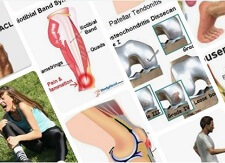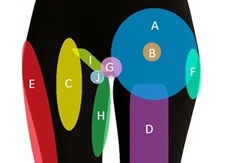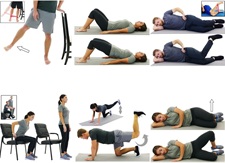- Home
- Hip Pain Diagnosis
- Snapping Hip
Snapping Hip Syndrome
Written By: Chloe Wilson, BSc(Hons) Physiotherapy
Reviewed by: KPE Medical Review Board
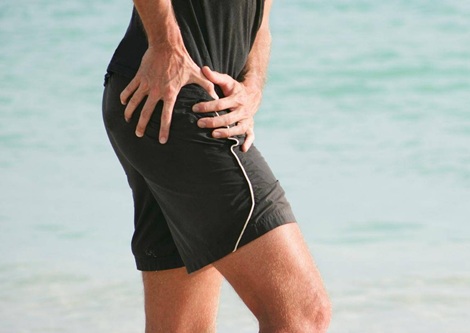
Snapping Hip Syndrome (SHS) is a condition characterized by a snapping or popping sensation in the hip during movement.
The snapping typically comes from tendons or muscles flicking over bony parts of the hip, but it can also be due to problems inside the hip joint itself.
In most cases, there is no pain associated with the hip popping and snapping, but for some people, there may be pain in the hip, buttocks or thigh.
Snapping hip syndrome is common among dancers, athletes, and individuals engaging in activities requiring repetitive hip motions and can occur at any age.
Here we look at the common causes, symptoms, and treatment options for hip popping and snapping.
What Is Snapping Hip Syndrome?
Snapping hip syndrome, aka Coxa Saltans or Dancer’s Hip, occurs when a muscle or tendon flicks over a bony prominence in the hip, leading to a snapping, clicking or popping sound or sensation. There are four primary types of snapping hip syndrome.
1. External Snapping Hip
External snapping hip syndrome typically occurs when tightness or thickening of the iliotibial band (ITB) or gluteus maximus tendon causes it to snap over the greater trochanter, the bony prominence on the outer side of the hip.
A snapping noise or sensation may occur when bending, straightening or twisting the hip. It’s the most common type of hip popping and snapping and often affects active individuals.
With external snapping hip syndrome you may notice a snapping noise or sensation when walking, climbing stairs, or rotating the hip.
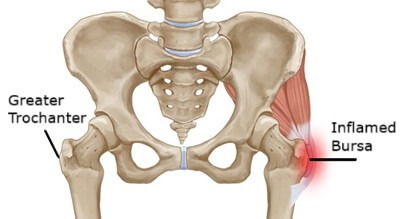
The snapping is typically painless at first, but over time, this can irritate the underlying bursa, a small fluid-filled sac that sits between the tendon and the bone, resulting in trochanteric bursitis and outer hip pain.
Risk factors include:
- Repetitive Hip Motions: running, cycling, dancing
- Poor Hip Flexibility: or alignment
- Muscle Imbalances: tight TFL, weak glutes
2. Internal Snapping Hip Syndrome
Internal hip snapping, also referred to as anterior snapping hip, occurs at the front or inner side of the hip and involves the movement of deep hip flexor tendons over bony structures. It typically causes front hip pain or inner hip pain.
Internal snapping hip pain may be caused by the iliopsoas tendon or rectus femoris tendon snapping over the front of the hip bone, at the iliopectineal eminence or femoral head, as you bend and straighten the hip.
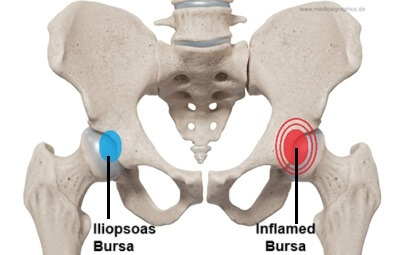
Over time, it may lead to irritation of the bursa at the front of the hip, resulting in iliopsoas bursitis.
Internal hip snapping pain is typically felt as a deep, clicking or snapping sensation in the groin during movements like rising from a chair, extending the hip, or swinging the leg forward.
Risk factors include:
- Repetitive Sports: requiring lots of hip flexion/extension and rotation e.g. martial arts, ballet, soccer
- Poor Core Strength: or pelvic stability
- Sedentary Lifestyle: leading to shortened hip flexors
3. Posterior Hip Snapping
A posterior hip popping sound or snapping occurs at the back of the hip, in the lower buttock region, and is the least common type of hip snapping syndrome.
With posterior hip popping pain, the, hamstring tendons, particular biceps femoris, snap over the ischial tuberosity, the bony point at the bottom of the pelvis, when extending the hip. It typically affects runners or athletes with tight or overactive hamstrings.
4. Intra-Articular Snapping Hip
Intra-articular snapping originates within the hip joint itself, and is less common but potentially more serious or painful. It can be caused by:
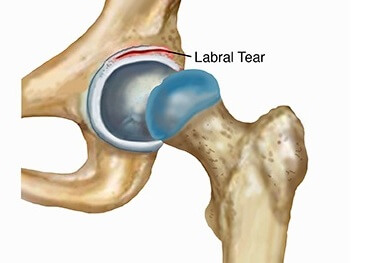
- Labral Tears: damage to the cartilage rim (labrum) that lines and cushions the hip socket can lead to clicking, catching or locking sensations
- Loose Bodies: floating fragments of cartilage or bone that move freely within the joint can cause intermittent snapping and joint instability and interfere with normal hip motion
- Cartilage Damage: degenerative joint disease or trauma can disrupt smooth joint surfaces, producing grinding or catching sensations.
- Femoroacetabular Impingement (FAI): Abnormal joint shapes can cause bones to pinch or snap during movement.
- Synovial Chondromatosis: a rare condition where nodules form in the synovial membrane
Intra-articular snapping is often accompanied by a catching or locking sensation, stiffness, and pain deep in the groin or hip joint.
Snapping Hip Causes
Common causes of snapping hip syndrome include:
- Overuse or Repetitive Movements: Sports or activities
involving repeated extreme hip motion, like dancing, running, soccer, or
martial arts, can lead to irritation and snapping over time. Almost 90% of
competitive ballet dancers report snapping hip symptoms, which is why it is
often referred to as Dancer’s Hip. Repetitive overuse is the most common cause
of snapping hip syndrome
- Muscle Tightness & Imbalance: Tight hip flexors,
hamstrings, or the IT band can increase friction against nearby bones,
especially if the surrounding muscles are weak or
underactive
- Structural Abnormalities: Conditions like hip dysplasia or
femoroacetabular impingement (FAI) can create abnormal joint shapes that
increase the risk of snapping and pain during movement
- Poor Biomechanics: Improper posture, muscle weakness or
tightness, or abnormal walking/running mechanics can increase stress on
tendons, leading to repetitive snapping and inflammation
- Age: Snapping Syndrome is particularly common in adolescence due to sudden growth spurts
Coxa Saltans affects around 5-10% of the population, with most people reporting painless snapping
Snapping Hip Symptoms
Symptoms vary depending on the type of snapping hip syndrome, but typically include:
- Hip Snapping or Popping: in the hip, often heard during hip
movement e.g. walking, getting up from a chair, swinging the leg. You may be
able to hear, see or feel the snap
- Painless Snapping: in most cases, especially in external
snapping hip
- Hip Or Groin Pain: most common with internal or
intra-articular snapping, especially after prolonged activity e.g. running,
cycling or dancing, when lying on the affected side or in cases involving inflammation, hip tendonitis or hip bursitis
- Hip Catching or Locking Sensation: Particularly during
specific movements
- Hip Or Thigh Tightness: especially in the ITB or hip flexors.
The hip joint may also feel stiff, particularly in intra-articular cases
- Swelling or Tenderness: over the greater trochanter or hip
flexor region
- Weakness or Tightness: In the hip or surrounding muscles
Diagnosing Hip Popping
Diagnosing snapping and popping in the hip typically involves a combination of medical history, physical examination, and imaging studies:
1. Clinical History
Your healthcare provider will ask questions about:
- When the snapping or popping began
- Whether it's painful or painless
- Which movements trigger the snapping
- Your activity level e.g. dancing, sports, running
- Any recent injuries or changes in activity
2. Physical Examination
They will then carryout a detailed physical examination during which they may:
- Ask you to reproduce the snapping by flexing and extending your hip
- Palpate specific hip structures to identify tenderness
- Test strength, flexibility, and range of motion in the hip and surrounding muscles
- Assess for tightness in the ITB, iliopsoas, or hamstrings
- Perform provocative tests e.g. Ober’s test, Thomas test, to help identify the source of snapping
3. Imaging Studies
If intra-articular pathology is suspected or symptoms are persistent, imaging may be recommended such as:
- Ultrasound: Useful for visualizing tendon movement in real-time; can help confirm external or internal snapping
- X-ray: Can detect structural abnormalities like dysplasia or bone spurs
- MRI or MR Arthrogram: Ideal for evaluating soft tissue injuries, including labral tears, cartilage damage, and inflammation
- Diagnostic Injections: Anesthetic injections into specific areas (e.g. iliopsoas bursa or hip joint) can help pinpoint the pain source
Differential Diagnosis
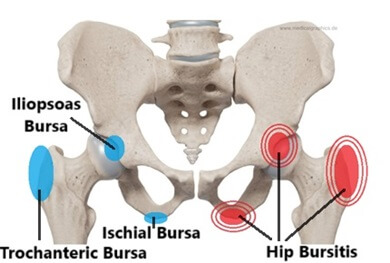
There are some other conditions that can cause similar symptoms to snapping hip syndrome:
When to See a Doctor
You should seek medical attention if:
- The hip snapping is painful or getting worse
- You experience locking, catching, or instability
- There is significant swelling, bruising, or difficulty bearing weight
- Pain is affecting your activity level or sleep
- Symptoms don’t improve with rest and basic stretching
#CommissionsEarned from Amazon on qualifying purchases
Hip Snapping Syndrome Treatment
The good news is that most cases of snapping hip syndrome, whether it is from hip popping on the outside, front, or deep in the joint—can be successfully treated without surgery. The best treatment approach depends on the cause, severity of symptoms, and how much it is affecting daily activities or sport and may include:
1. Rest & Activity
Modification
If you are experiencing hip snapping or popping, the first step is to reduce activities that aggravate the symptoms, especially repetitive hip flexion or rotation. This might mean:
- Temporarily stopping running, jumping, or dancing
- Avoiding deep squats or lunges
- Reducing hill walking or stair climbing
Allowing the irritated tendons and tissues time to settle is often essential for recovery.
2. Ice & Anti-inflammatory Measures
Applying ice packs to the hip for 15–20 minutes, several times per day, can help reduce inflammation, especially if there is inflammation e.g. trochanteric bursitis
Over-the-counter nonsteroidal anti-inflammatory drugs (NSAIDs) like ibuprofen or naproxen can also help ease snapping or popping hip pain and reduce inflammation in the short term.
3. Physical Therapy
Physiotherapy is the most important long-term treatment for snapping hip syndrome. A tailored rehab program can address the underlying biomechanical issues causing the snapping.
Key components of physical therapy include:
- Stretching Tight Muscles: particularly Iliopsoas, IT band, rectus femoris, hamstrings, and TFL (tensor fasciae latae). Gentle, sustained stretching helps reduce friction over bony prominences.
- Strengthening Weak Muscles: Focus on core, glutes (especially glute medius and maximus) and pelvic stabilizers. Hip strengthening reduces abnormal movement patterns and improves alignment.
- Manual Therapy: Techniques such as myofascial release, dry needling, or joint mobilizations may be used to release soft tissue tension or improve hip mechanics.
- Posture & Gait Retraining: Correcting poor movement habits can reduce stress on the hip and prevent recurrence.
- Progressive Return to Sport or Activity: A structured return-to-play or return-to-run program helps reintroduce loading in a safe way.
4. Foam Rolling & Self-Massage
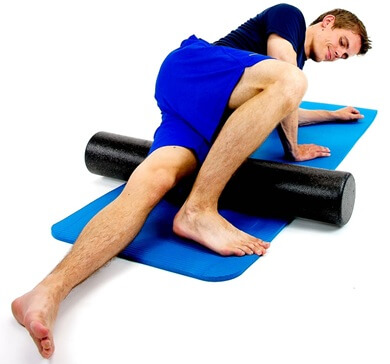
Using a foam roller to release tight fascia or muscle groups around the hip, especially with IT band stretches, quads stretches, glutes stretches, and hamstring stretches, can improve flexibility and reduce tendon irritation.
Applying pressure to the soft tissues using a roller helps to relieve tension.
Care should be taken not to overdo it, especially if pain levels are high.
5. Corticosteroid
Injections
If conservative treatment doesn’t provide relief, and there is clear inflammation, particularly in the iliopsoas bursa or trochanteric bursa, a corticosteroid injection may help.
These hip injections can:
- Reduce inflammation and pain quickly
- Be used diagnostically to confirm the source of snapping or pain
- Allow more effective participation in physiotherapy
However, injections are generally not a long-term solution for hip popping pain and should be used sparingly as they can cause temporary weakness.
6. Surgery
Surgery is rarely needed with snapping hip pain and is usually only considered when:
- Symptoms persist after at least 6–12 months of structured rehab
- Snapping is interfering significantly with daily life or sport
- There is a structural cause such as a labral tear, loose body, or hip impingement
Surgical options may include:
- Tendon Lengthening or Release: for tight iliopsoas tendon or IT band
- Hip Arthroscopy: To address intra-articular causes like labral tears or loose bodies.
- Bursectomy: to remove chronically inflamed bursae
Recovery time can vary, but physiotherapy remains crucial after surgery to regain strength, flexibility, and control.
Preventative Strategies
To avoid recurrence of hip popping pain, it is important to:
- Warm up thoroughly before activity
- Maintain flexibility and strength through regular hip exercises
- Avoid overtraining or sudden increases in training intensity
- Cross-train to reduce repetitive strain on the same structures
FAQs on Hip Snapping
Why Is My Hip Popping?
Why Is My Hip Popping?
Hip popping sounds often happen when a tendon or muscle flicks over a bony point in the hip, causing a snapping sensation. This is usually harmless and painless, but can become painful if the tendon or surrounding soft tissues gets irritated or inflamed over time.
How To Fix Hip Popping?
How To Fix Hip Popping?
The best way to fix hip popping it to start with rest, stretching tight muscles (especially the hip flexors and IT band), and strengthening the glutes and core. If symptoms persist, physiotherapy or, in rare cases, corticosteroid injections or surgery may be needed. Snapping hip syndrome exercises are one of the best ways to fix snapping and popping in hip.
What Causes Hip Popping When Walking?
What Causes Hip Popping When Walking?
Snapping or popping in hip during walking is usually due to the IT band or gluteus maximus snapping over the outer hip bone. Tight muscles, poor walking mechanics, or weak hip stabilizers can increase the likelihood of this happening.
What Causes Hip Popping When Lifting the Leg?
What Causes Hip Popping When Lifting the Leg?
When lifting the leg, the iliopsoas tendon may snap over the front of the hip, known as internal snapping hip syndrome. This is common in dancers and athletes, especially if the hip flexors are tight or overworked.
What Causes Sharp Pain in the Front of the Hip?
What Causes Sharp Pain in the Front of the Hip?
Sharp front hip pain may indicate a hip flexor strain, iliopsoas bursitis, labral tear, hip flexor tendonitis or femoroacetabular impingement. If the pain is sudden or worsens with movement, it is best to get it assessed by a healthcare professional.
How to Stretch the Front of the Hip?
How to Stretch the Front of the Hip?
A kneeling hip flexor stretch is great for targeting tight front-hip muscles.
- Start in a lunge position with one knee on the floor
- Gently shift your weight forward while keeping your torso upright
- You should feel a stretch at the front of the hip on the kneeling leg
- Hold the position for 30 seconds while gently pushing the hips forward and keeping the back upright for the best results, repeat 2–3 times per side
Snapping Hip Syndrome Summary
Snapping hip syndrome, also known as Coxa Saltans or Dancer’s Hip, is a condition where a snapping or popping sound or sensation occurs in or around the hip during movement. It can stem from tight tendons flicking over bony structures or from issues within the hip joint itself, such as a labral tear. While it is often painless at first, it can lead to hip discomfort and restricted mobility over time.
Common causes of snapping hip syndrome include tight hip flexors, IT band irritation, weak glutes, and repetitive overuse, especially in dancers and athletes. Symptoms may include an audible snap, a catching feeling, and sometimes pain with specific movements.
Treatment for hip popping or snapping usually starts with activity modification, stretching, and hip strengthening exercises, particularly targeting the glutes, core, and hip stabilizers. Physical therapy is often effective, and in more persistent or severe cases, injections or surgery may be required.
With the right approach, most people can recover fully and return to their usual activities symptom-free.
You may also be interested in the following articles:
- Front Hip Pain
- Outer Hip Pain
- Inner Thigh Pain
- Pain In Top Of Thigh
- Groin Strain
- Hip Bursitis
- Hip Tendonitis
- Hip Muscle Anatomy
- Knee Pain Diagnosis Chart
Related Articles
Knee Pain Diagnosis
March 27, 2025
Hip Pain Diagnosis
September 16, 2025
Hip Strengthening
September 24, 2025
Last Updated: September 17th, 2025
Next Review Due: September 17th, 2027
